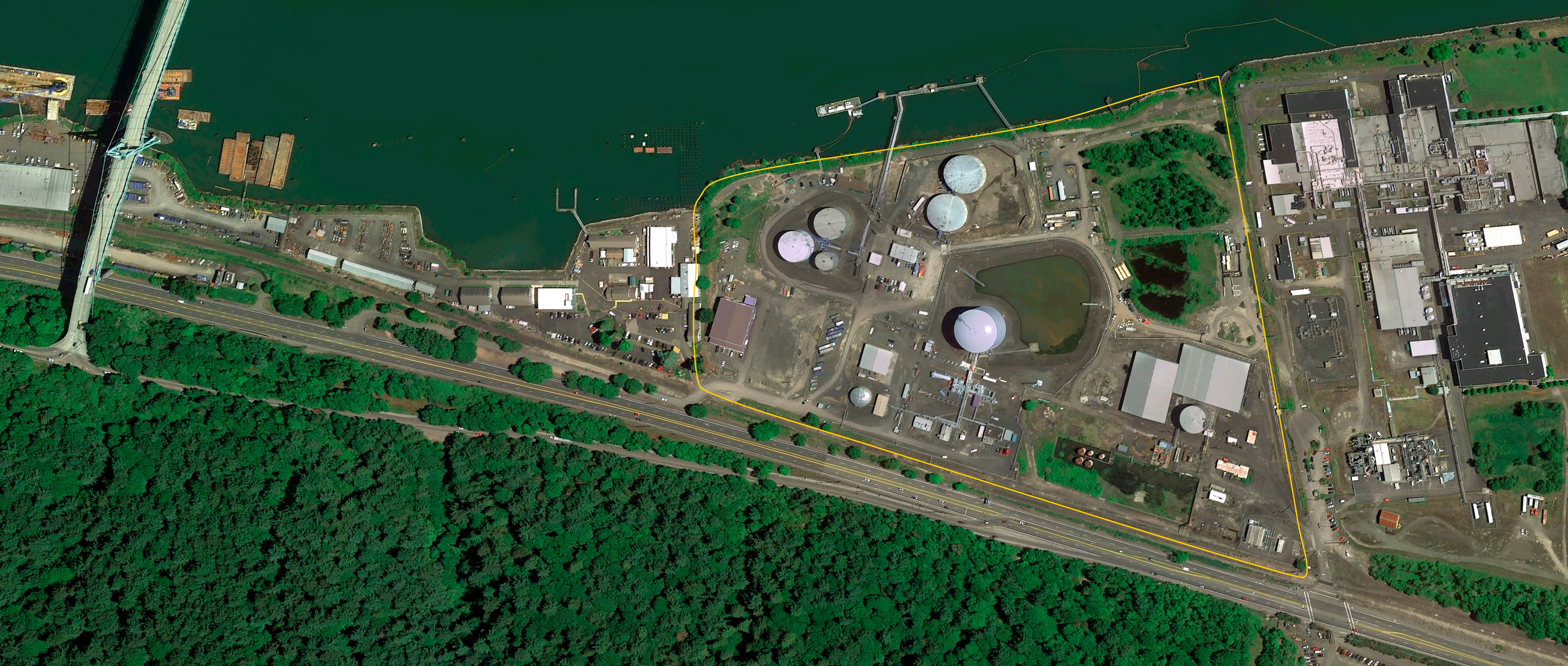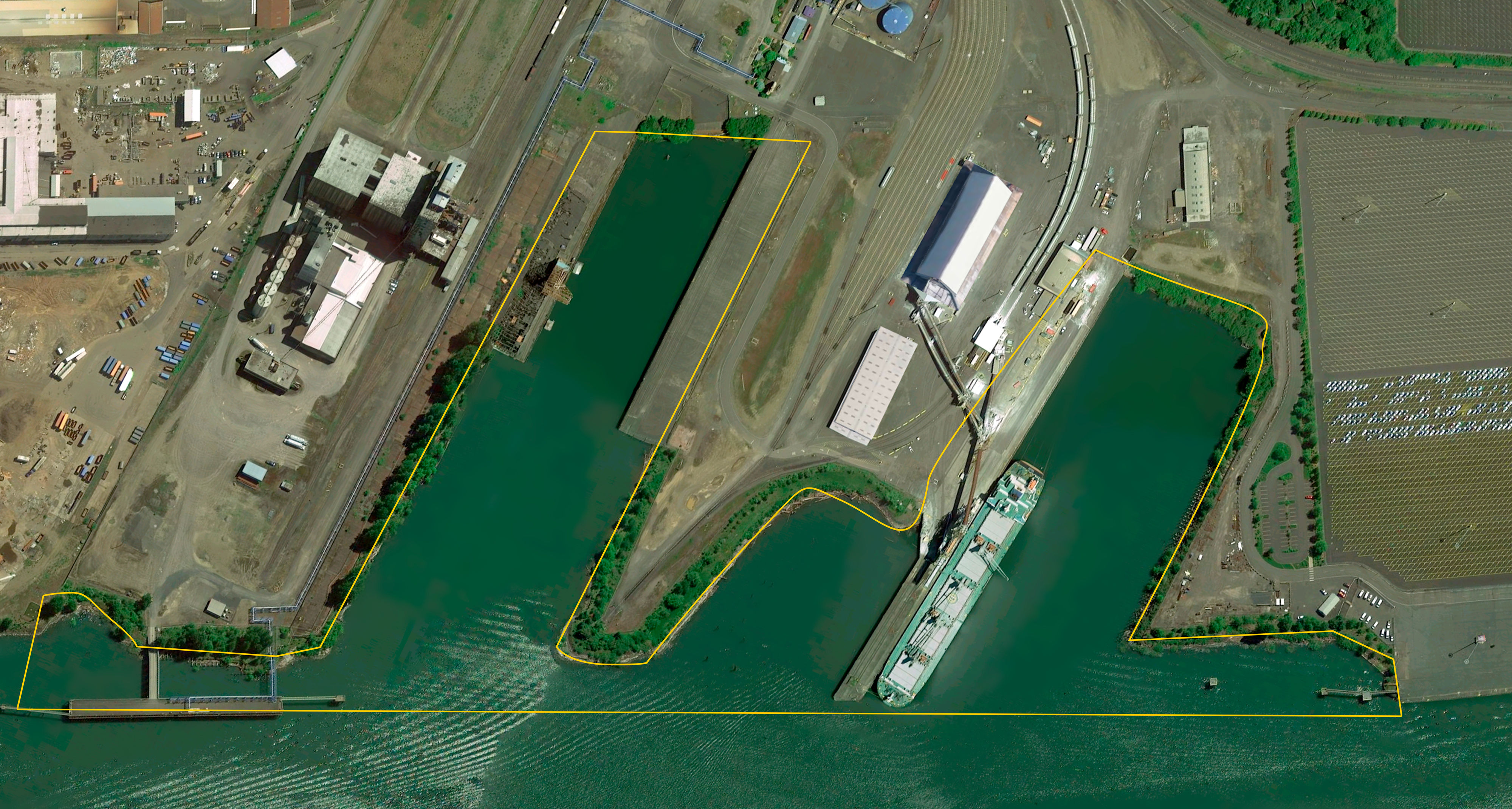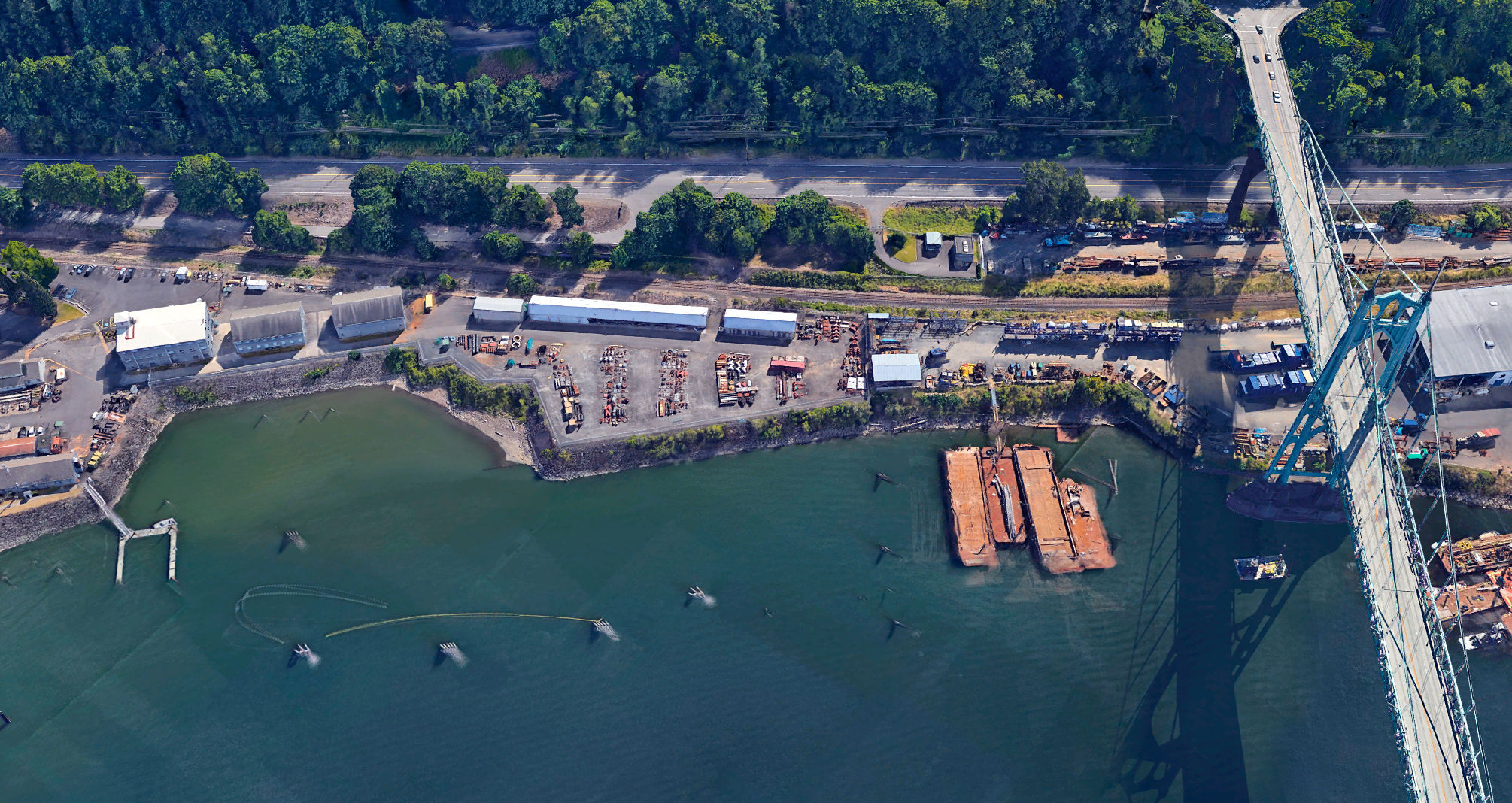Site: River MIle 11
Site: River MIle 11
Work is ongoing at the Portland Harbor/Willamette River River Mile 11 East (RM11E) area, under the direction of EPA Region 10, to support remedy selection and implementation in the area. Remedial action will be based on the
River Mile 11
River Mile 11Site: Gasco
Gasco Sediments Site – Bob Wyatt, NW Natural
GascoSite: Gasco
EPA found the site to have the highest levels of PAHs in the harbor.
Gasco is a former manufactured gas plant which deposited wastes into upland tar ponds for many years. The site is located near river mile 6.5 between the St. Johns and Railroad bridges on the southwest side of the Willamette River. The tar ponds overflowed into the Willamette River for decades. The overflow remnants were visible during low river stages and were eroding. Removal of tar deposits in the river was completed in the fall of 2005. These deposits contained hazardous substances such as TPAH, benzene, and cyanide.
History of the Site and Contamination
According to the EPA:
Gasco purchased the site in approximately 1910. At that time, the site was larger, approximately 85 acres. Today the site is 44.65 acres. Gasco built and operated an oil gasification plant on the site between 1913 and 1956. Between 1913 and 1923, only gas and lampblack briquettes were produced. In 1923, by-products refining began. After 1925, when tar refining operations began, the quantity of tar within the waste stream would have decreased, but waste tar in the effluent continued to occur as suspended material and emulsions from the secondary tar box. Prior to 1941, all wastewater effluent and tar
Early Action
As mentioned above, early action in 2005 removed tar deposits that contained hazardous substances such as TPAH, benzene, and cyanide.
In 2009 EPA found that “[c]ontaminants known to be present at the Gasco/Siltronic facility that pose a substantial risk to human health or the environment include naphthalene, cyanide, benzene, tars, oil, creosote, phenols, polynuclear aromatic hydrocarbons (PAHs), BTEX, phthalates, Carbazole, chlorophenol, chrysene, cobalt, DDT, dibenzofuran, dimethylphenol, ethylbenzene, pyrenes, manganese, PCP, VOCs, (such as vinyl chloride, TCE, toluene, and others which are commingled with MGP wastes) and lead, starting in the uplands and continuing through the riverbank and into sediment in the river.” (Gasco Siltronic Approval Memo, p. 4-5).
EPA approved the development of an EE/CA to analyze early action cleanup in light of the greater
Stay tuned for updates on any cleanup activity at this site.
Video: Groundwater Source Control at Gasco
Site: Arkema
Brief: A former pesticide manufacturing facility contaminated with high levels of DDT and other chemicals.
History: Manufacturing operations began at the site in 1941 by Pennsylvania Salt Manufacturing, and ceased in 2001. The facility produced various chemicals including sodium chlorate, potassium chlorate, chlorine, sodium hydroxide, DDT, sodium orthosilicate, magnesium chloride hexahydrate, ammonia, hydrogen, ammonium and sodium perchlorate (rocket fuel) and hydrochloric acid.
Contamination Information: The facility primarily produced chlorine, but also produced hydrochloric acid, hydrogen, sodium chlorate, and sodium hydroxide. Asbestos (used as a diaphragm in electrolytic cells) was historically buried in a pit on-site. The buried asbestos was removed in 1992 with DEQ Air Quality Program oversight. Waste diaphragm asbestos was subsequently conveyed to a filter press and the filter cake placed into drums for off-site disposal. “Brine purification residue” (a mixture of calcium carbonate and magnesium hydroxide) was initially managed in on-site ponds. Brine pond residue was subsequently removed and disposed in a off-site landfill. Brine residue was more recently dewatered in a filter press and the dry solids landfilled at a DEQ permitted landfill. Four Willamette River outfalls are present. Only one is currently active which is the most down stream of the four. It discharges treated stormwater and groundwater under NPDES permits. Six chemical spills were reported to have occurred at the site in 1987, the first year reporting was required. Excavation activities in 1992 encountered residues determined to be associated with the manufacture of DDT by Pennwalt in the late 1940s and early 1950s. DDT residue was removed by Atochem in a trench disposal area from the northwestern portion of the plant site in 1994. Investigation of the former DDT-manufacturing area (current acid plant area) by Atochem in 1994 showed high concentrations of DDT in soil and monochlorobenzene in groundwater. (11/21/01 MJM/VCP). Remedial investigation work detected hexavalent chromium, perchlorate, chloroform and chloride in site groundwater associated with former facility operations.
Arkema’s site, where industrial toxics were produced from 1941 to 2001, sits on the riverfront east of U.S. 30, just south of the Willamette railroad bridge. The $10 million barrier wall, made of the same material as a clay landfill liner, covers the southern half of the site, where DDT manufacturing took place from 1947 to 1954. It’s being laid about 30 feet from the riverbank. Wells behind the wall will capture groundwater, directing it to a treatment plant before it’s released into the river. A separate system routes stormwater through a huge detention pond and sand filter, which removes toxic metals.
Remediation: (10/29/97 MJM/VCP) Elf Atochem entered the DEQ Voluntary Cleanup Program (2/96) and requested DEQ oversight for the investigation & cleanup of the former DDT manufacturing area (former Acid Plant area). Elf Atochem and DEQ entered Voluntary RI/FS Agreement to investigate former DDT manufacturing releases and to complete a RI of the facility. Fall 2000, ATOFINA removed approximately 3,000 cubic yards of soil with some of the highest levels of DDT . ATOFINA also paved or placed temporary covers over areas of the plant to control surface soils containing DDT from being transported by stormwater to the Willamette River. In December 2000, ATOCHEM constructed and started operation of a vapor-extraction system to remove chlorobenzene from vadose zone soils in the location of the former chlorobenzene recovery unit. Plant operations ceased in 2001; phased demoloition of the plant structures occurred through 2005. A number of pilot and full-scale interim removal measures have been implimented since 2000. These include attempts to treat chlorobenzene and DDT with sodium persulfate, in-situ reduction of hexavalent chromium to trivalent chromium using calcium polysulfide and treatment of chlorobenzene by air sparging and soil vapor recovery.
Construction of upland source control measures began in April 2012 to control the migration of impacted stormwater and groundwater to the Willamette River.
* Stormwater – The existing stormwater collection and conveyance system was decommissioned including the upstream three NPDES outfalls. Surface soils in the more contaminated portions of the site were covered with temporary clean caps to prevent transport by stormwater. New stromwater conveyance channels, detention basin and sand filter were constructed and operational in October 2012.
* Groundwater – Construction of a 1600 lineal foot soil-bentonite slurry groundwater cutoff wall was completed in 2012. The wall is up to 88 feet deep and in contact with basalt bedrock. Construction of a groundwater collection and treatment system associated with the cutoff wall was completed in 2013 and became operational in 2014.
Site: terminal 4
The Willamette Cove property and adjacent river were fully occupied by industry for several decades which resulted in contamination issues that are being investigated and cleaned up by Metro and the Port of Portland. An investigation and risk assessment of the upland areas is being overseen by the DEQ. The investigation and clean up of the Willamette River adjacent to the Willamette Cove property will be managed by the EPA. The DEQ has determined that an area of unacceptable risk to site visitors exists at the western portion of the property due to Polycyclic Aromatic Hydrocarbons in these soils.
Terminal 4 Update
Terminal 4 UpdateSite: US Army COE – Portland Moorings
History: The site has been in operation since 1904, serving as a maintenance port for Corps of Engineers vessels. Contamination of Willamette River sediments has occurred partly as a result of site activities such as vessel maintenance (sandblasting, scaling, repair and painting, for example), and spills from vessels in
Site: Triangle Park
Located in North Portland,
A 51.6-acre site along the Willamette River, at the base of Waud Bluff, in the University Park area of North Portland. The site’s industrial history dates back to at least 1900 (nearly 50 industrial operations have occupied the site). Residential property and the University of Portland lie at the top of Waud Bluff. The site shares its northwestern property line with the McCormick & Baxter federal Superfund site. The site also lies within the boundaries of the Portland Harbor federal Superfund site.
(12/26/02 JMA/VCP) The site has been used for a variety of industrial activities since at least 1900. In the early
Cleanup In Action
Willamette River cleanup in progress: April 2018
Videos produced by Oregon DEQ
Portland Harbor Source Control
Portland Harbor Superfund Source Control — What it is, where it is, and what Oregon DEQ and our partners are doing to clean up our act and make sure the Willamette River doesn’t get contaminated again. This lively video presentation features animations, maps, and videos of stakeholders and DEQ staff at cleanup sites on the river.
Tire Fills & Replacements
The history and geography of Portland Harbor, and what it means to the people of Oregon.
History and Superfund Listing
How the lower reaches of the Willamette River became a Superfund site, and what that means to us.
What is Source Control?
DEQ is responsible for controlling sources of contamination into Portland Harbor. So how in the world are we doing this?
Groundwater Pathways
The groundwater under properties surrounding Portland Harbor is contaminated. Once it’s cleaned up, we must make sure it doesn’t get contaminated again.
Bank Erosion Pathways
Erosion of soil around the Willamette River brings harmful contaminants into the water. DEQ and our partners are working hard to keep that from happening in the future.
Stormwater Pathways
How do we keep Portland’s rains from washing contaminants back into the river? This is how.
Upstream Inputs
DEQ and the City of Portland have brought downtown Portland’s impact on the Willamette River to a minimum. That’s a good thing, because the river is an icon and a vital artery in the heart of Portland.
DEQ’s Source Control Summary Report
In November 2014, DEQ submitted to US EPA a summary of our ongoing efforts to control sources of pollution in Portland Harbor. This is a summary of our summary, which will help you understand the report when you read the real thing.
Groundwater Source Control at Gasco
DEQ and Northwest Natural teamed up to keep contaminated groundwater out of the Willamette River. See for yourself — it’s not easy, but we’re doing it. (Studio Kate video)
Sediment Removal and Groundwater
Source Control at BP Arco
The story of the BP/Arco site, and how a contaminated, failing seawall became a clean stretch of river due to cooperation between property owners and DEQ. (Studio Kate video)
Stormwater Source Control at Arkema
How were DDT levels in stormwater lowered by 99.8% at the heavily polluted Arkema site? (Studio Kate video)
Travis Williams, Willamette Riverkeeper
Travis Williams of Willamette Riverkeeper explains the importance of DEQ’s efforts in upland source control. (Studio Kate video)
Sediment Removal and Groundwater
Source Control at BP Arco
The story of the BP/Arco site, and how a contaminated, failing seawall became a clean stretch of river due to cooperation between property owners and DEQ. (Studio Kate video)
Bill Egan, Oregon Bass & Panfish Club
Bill Egan loves to fish the Willamette River. That’s why he wants to make sure we all keep it clean. (Studio Kate video)





